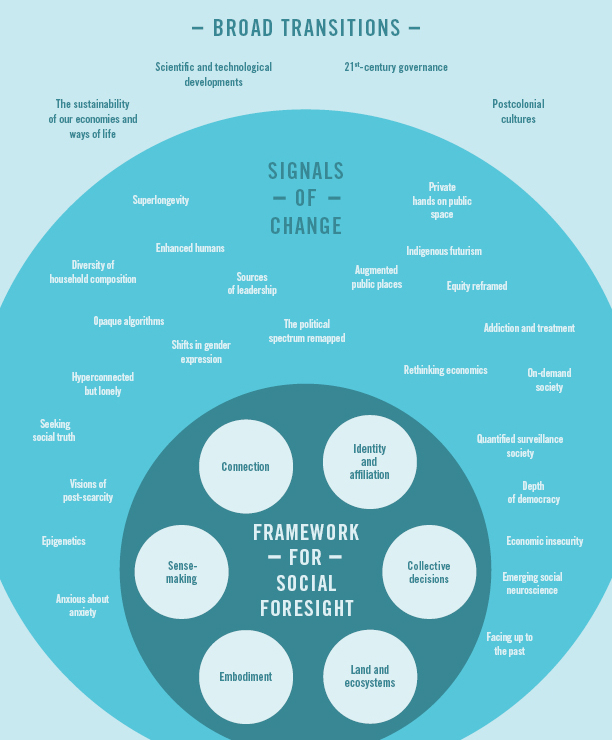Exploring Social Futures

DISCLAIMER
Policy Horizons Canada (Policy Horizons) is a strategic foresight organization within the Government of Canada with a mandate to help the Government develop future-oriented policy and programs that are more robust and resilient in the face of disruptive change on the horizon. The content of this document does not necessarily represent the views of the Government of Canada, or participating departments and agencies.
Table of contents
- Foreword
- Summary
- Social futures
- A framework for social foresight
- Changes in the social
-
- Hyperconnected but lonely
- Indigenous futurism
- Augmented public places
- Diversity of household composition
- Superlongevity
- Shifts in gender expression
- Economic insecurity
- Quantified surveillance society
- Opaque algorithms
- Addiction and treatment
- Epigenetics
- Facing up to the past
- Seeking social truth
- Anxious about anxiety
- Emerging social neuroscience
- Enhanced humans
- Equity reframed
- The political spectrum remapped
- Private hands on public space
- Visions of post-scarcity
- Rethinking economics
- Depth of democracy
- Sources of leadership
- On-demand society
- Conclusion
- Acknowledgements
- Endnotes
Foreword

Our social systems could see significant change over the coming decades. Our institutions are undergoing transitions, with some showing significant stress. The Next Digital Economy will likely have a disruptive impact on society: core social relationships are evolving, values and measurements of value are being questioned, and new scientific knowledge and technologies could change our relationships with biology and our living environment. These are just a few of the factors that will affect our social lives in the near future.
Changes in social functions, and more broadly in the social systems, will have implications across many policy areas. Beyond reflections on what social futures might emerge, social futures also involve conversations about what social lives we want.
Guided by its mandate, Policy Horizons Canada (Policy Horizons) will explore social futures and related policy questions. In this initial paper, we define what we mean by social futures, frame social foresight as an exploration of what might be changing in the broad functions of social life, and highlight some initial policy-relevant signals of change.
No major foresight project can be accomplished solely by isolated research. Our social foresight will require broad engagement with policy makers, partners, and stakeholders to produce plausible and informed pictures of what could change, and what that might mean for diverse groups of Canadians.
We welcome your comments and participation as we dive more deeply into this domain.
Kristel Van der Elst
Director General
Policy Horizons Canada
Summary

What do we mean by social foresight?
Social foresight relates to the diverse, complex, and changing web of sentiments, bonds, and processes by which we relate to each other. It questions how these social functions could change in the future, how these could combine to disrupt the social system, what future social systems might look like, and what those changes mean in terms of policy implications, opportunities, and challenges.
Why social foresight now?
- Social processes and institutions are undergoing strain
- Major disruptions are foreseeable on the horizon
- Foresight literature & expert interviews confirm the value of social foresight
Social foresight could be scoped according to functions of social life that are relevant to the policy landscape for many departments and agencies across government. These include:
- How we connect to one another
- How we make sense of our world
- How we identify as individuals, affiliate in groups, and negotiate differences
- How we make collective decisions
- How we relate to ourselves and others as bodies
- How we relate to the land and ecosystems
Changes in the social

Broad transitions
- The sustainability of our economies and ways of life
- Scientific and technological developments
- 21st-century governance
- Postcolonial cultures
Signals of change
- Hyperconnected but lonely
- Indigenous futurism
- Augmented public places
- Diversity of household composition
- Superlongevity
- Shifts in gender expression
- Economic insecurity
- Quantified surveillance society
- Opaque algorithms
- Addiction and treatment
- Epigenetics
- Facing up to the past
- Seeking social truth
- Anxious about anxiety
- Emerging social neuroscience
- Enhanced humans
- Equity reframed
- The political spectrum remapped
- Private hands on public space
- Visions of post-scarcity
- Rethinking economics
- Depth of democracy
- Sources of leadership
- On-demand society
Framework for social foresight
- Connection
- Identity and affiliation
- Collective decisions
- Land and ecosystems
- Embodiment
- Sense-making
Social Futures
What is Policy Horizons’ framing of social foresight?
From its origin, the word ‘social’ has referred to a bond founded on a mutually acknowledged community of interest, sustained through repeated interactions. From this perspective, society emerges from ‘the social’. It is a product of the diverse, complex, and changing web of sentiments, bonds, and processes by which we relate to each other. This web shapes our individual biology, behaviour, perception, and experience, as well as our collective institutions and environments.
This framing means that aspects of virtually all areas of human endeavor and experience can fall within the social. The economy is social. Work is social. So are technology, education, art, family, infrastructure, design, politics, and governance.
Policy Horizons’ social foresight work emphasizes the interpersonal sentiments, bonds, and processes across all these domains. It focuses on disruptions to how and where people interact, with whom, how they create meaning and define identities, how they make decisions, and how people relate to their bodies and the environment. It questions how these social functions could change in the future, how these could combine to disrupt the social system, what a future social system might look like, and what those changes mean in terms of policy implications, opportunities, and challenges.

“Human behaviour and societal changes are often shaped by deep, hidden and interconnected forces that–because of complexity–might not be fully apparent for years.”
P. Ho, Senior Advisor, Centre for Strategic Futures and former Head of Singapore’s Civil Service1
Why explore social futures now?
The time is right for social foresight. Other foresight institutions have also begun exploring this.2
Several factors may be driving the shift towards social futures. Policy Horizons’ interviews with experts indicate that social processes and institutions, such as environmental decision making, liberal democracy, the welfare state, employment, education, and the information environment, appear to be under great strain – possibly approaching breaking points. Technological or standard economic interventions may not suffice to meet the challenges that these situations represent.
There is also a widespread belief that this strain and instability could persist in the foreseeable future, which makes significant social change probable over the coming years. Most significantly, there is growing awareness of the social experience as a source of disruptive change felt in other domains from city planning to climate action.
This initial scoping report emerges from four streams of research:
- weak signals and insights developed through ongoing horizon scanning
- identification of key trends based on analysis of population statistics and surveys
- a review of relevant social foresight literature
- interviews with 59 academic experts, public intellectuals, researchers, business leaders, and senior public servants
A framework for social foresight
To organize social foresight in a way that helps policy makers across many departments and agencies, Policy Horizons suggests exploring what might be changing in the broad functions of social life, such as:
- How we connect to one another: What could disrupt or increase our ability to make contact, trust, develop relationships, empathize, support, accept, and build lives and communities with one another?
- How we make sense of our world: What could change in the ways that we receive, process, and weigh information? How might we integrate our feelings and observations, and draw on traditions of knowledge and wisdom? How might we build meaning, communicate perspectives, and develop visions of our social world?
- How we identify as individuals, affiliate in groups, and negotiate differences: What could change in the way we describe, categorize, and identify as individuals and as members of groups? What changes could we see in how, where, and why we connect with others? What could change in the ways we understand our differences, treat new claims for equity and justice, and approach diversity?
- How we make collective decisions: How could we change the way we develop and consider options, anticipate consequences, mediate conflicting values, and take – or fail to take – effective collective decisions?
- How we relate to ourselves and others as bodies: What changes could emerge in the way we understand, care for, heal, modify, and treat bodies? How might emerging science, technology, philosophy, and Indigenous experiences and ways of being change our approach to embodiment, and policies towards health and human development?
- How we relate to the land and ecosystems: What could change in our social relationships with our ecosystem? What plausible visions of the future could motivate change on the scale that is required to address our environmental problems, such as climate change and extinction?
Changes in these social functions – combining in broader social systems – will likely have consequences on almost all areas of government activity, from environmental regulation and fiscal policy, to immigration, health, public safety, the justice system, Crown-Indigenous relations, natural resources, and cultural heritage.
All government activities involve people – whether as government employees, members of organizations, experts, or community members. So all governance is fundamentally social. Policy makers can benefit from reflection on what future social systems might look like, what social futures Canadians will want, and the policy implications that could result.
Changes in the social
The following section explores some initial policy-relevant signals of change that emerged from our scoping work. Each could potentially produce changes and develop in surprising ways.
The trends and signals discussed below can be understood in the context of larger transitions, including in:
- the sustainability of our economies and ways of life
- scientific and technological developments
- 21st-century governance
- postcolonial cultures
Social foresight can give us clues about how a changing society could design, build, and cross the bridges that could take us through these transitions together.
Hyperconnected but lonely

Some say that loneliness and social isolation should be seen as a public health crisis.3
Recent research suggests that loneliness and social isolation are growing in developed countries, with consequences for public health and safety. The U.S. Surgeon General’s 2017 report on loneliness,4 and initiatives such as the UK government’s loneliness strategy, show that awareness is widespread,5 and solutions are not straightforward.
Loneliness has a complicated relationship with networked technology. Although we are digitally connected in ways that were unthinkable only a few years ago, these connections also mediate and sometimes replace human-to-human contact that would otherwise promote deeper interpersonal bonds and intimacy. As digital fora with new properties take up more time and attention, previous real-world spaces for social connection, such as places of worship, libraries, community centres, and even shopping malls, may see drops in attendance and relevance.
While we could see new varieties of loneliness or disconnection emerge, we could also see new counter-strategies. Loneliness straddles the culture-health divide, and a focus on loneliness may invite us to examine new policy questions, for example in the field of digital public health.
Indigenous futurism

While the federal government must respect Aboriginal rights recognized in Canada’s Constitution, Indigenous leaders, organizations, and communities are increasingly pursuing innovative ways and other partnerships to overcome barriers they face in exercising those rights. These innovations sometimes depend on getting outside of Indian Act management (e.g. First Nations Land Management, modern treaties). New forms of self-determination could be a significant source of change in the future.6
These promising changes could surface conflicts: robust institutional, legal, and material self-determination may exceed the level of some non-Indigenous Canadians’ understanding and support for Reconciliation.7 Many non-Indigenous Canadians may be unfamiliar with foundational ideas advanced by Indigenous leaders, such as pre-existing and concurrent Indigenous constitutional orders and treaties on the land known as Canada.
At the same time, Indigenous futurists are creating alternative symbolic frameworks for a self-determined future that goes beyond Reconciliation. They are correcting the exclusion of Indigenous people8 from popular visions9 of the future. For example, some Indigenous scholars10 argue that Indigenous ways of knowing, particularly relating to kinship with non-human beings, could provide a flexible ethical paradigm for thinking about artificial intelligence (AI).11 Others reframe apocalyptic thinking in mainstream popular culture by describing Indigenous perspectives as the cultural knowledge of societies that have already survived apocalypse.12
Augmented public places

Augmented reality (AR) involves layering computer-generated sensory objects, such as pictures, videos, animated characters, sounds, and even tactile digital experiences, into the physical world. That digital content can be made to interact with the landscape, objects, people, and other living beings. In the near future, smart glasses and other 5G-connected devices could allow people to experience public places very differently. Visitors to a public space may soon be able to embroider it with their own persistent virtual creations, as well as experience content left in the space by others.13
The days of ‘read-only’ access to public spaces could be coming to an end.
Augmented public space could bring us together in richer, multi-authored, shared social spaces. This could mean less control by property owners and governments over how public places and objects (such as monuments, buildings, and infrastructure) look, sound, feel, and behave. As a result, public places could become more chaotic, interesting, funny, lively, disturbing, informative, and relevant. The stories presented in public places could become highly pluralistic. Indigenous knowledge may interact in new ways with other location-based stories presented by governments, owners, and visitors. Conflicts about monuments of historical figures15 with complex legacies16 could play out directly in the space occupied by the monument, potentially using public places to help us understand our history. In short, shared augmented experience of public places could add new layers to social life.
But the opposite could also be true. Individuals may choose to interact with augmented space only through highly customized ‘skins’ or ‘lenses’, foregoing the breadth of other perspectives to experience only what aligns with their values and preferences. This could be a response to an augmented reality littered with uncivil,17 hateful,18 and unwanted explicit content, such as what currently plagues the comment sections of online news,19 and degrades women’s experiences of messaging applications and dating sites.20 Some people may even choose to digitally erase elements of the physical or social world from their augmented experience. As a result, individuals could find themselves in augmented physical versions of the ‘echo chambers’ or ‘filter bubbles’ that we currently see on social media.
New public policy challenges could emerge if we have little or no sense of what the people physically around us are seeing, hearing, and experiencing. The balance between customization and sharing is a critical uncertainty for social futures.
Diversity of household composition

‘Mommunes’ are communes where single mothers can share responsibilities and costs.21
Household composition is changing. One-person households are now the most common type (28.2%22), mirrored by a rise in condo ownership.23 In a countercurrent, a third of young adults aged 20-34 live with their parents, reflecting a tendency towards multigenerational living.24 Other forms of cohabitation are emerging, such as ‘mommunes’ in which single mothers live together, sharing costs and childcare duties.25 Similarly, cooperative housing ventures are springing up to serve the live-work-play demands of a new working class in cities where housing is unaffordable even for professionals.26 Despite a steady interest in marriage (millennials aspire to wed at the same rate as adults in the 1970s), we are also seeing a rise of singlehood and ‘living apart together’.27
Togetherness and contact at home may be changing too, as non-standard work hours affect shared mealtimes and other opportunities for families to connect. Social media, social robots, and AI friends could increasingly replace face-to-face interactions with humans, raising concerns about the decline in empathy.30
The rise of gig and virtual work opportunities for digital nomads could alter location choices. If workers do not need to relocate, they may choose to reside closer to family and friends. Stay-at-home workers may reinvigorate neighbourhood life during the day and create new options for combining dependent care with work responsibilities.31
New (or new to the spotlight) approaches to family life are available, such as having children without men,32 the rise of polyamory in dating,33 and some millennials choosing to either significantly delay having children or not having any.34 Declining fertility rates in Canada could affect a baseline element for social policies, including immigration and workforce planning.35
Superlongevity

Canadians could live much longer, in a population already experiencing demographic aging. Medium-growth population projections anticipate that Canada will age most rapidly until 2031, when the entire remaining baby boom generation will be over 65 (23% of Canadians, compared to 16.9% in 2016).36 Centenarians are already the fastest growing population, up 41.3% in five years37 to 0.023% of Canadians in 2016.38 Canada is among the few aging countries whose total population is expected to grow over the next 50 years, largely due to immigration.39
Healthier lifestyles and a wide range of emergent healthcare and consumer technologies could extend the lifespans and active participation of the next cohorts of seniors. A future with more personalized and predictive medicine40 could better prevent and treat major chronic diseases, while fields such as regenerative medicine and senolytics seek to prevent the aging process itself.41
Seniors’ living arrangements could also change: their healthcare could increasingly occur at home, aided by smart technologies (smart homes,42 Internet of Things,43 self-driving cars44) as well as co-housing arrangements45 and robots.46
For many, longer lives could mean an extension of years in good health. This could offer opportunities to rethink the timing of important life events such as education, childbirth and child raising, work, midlife sabbaticals, and retirement. It could change how Canadians think about relationships and investments across their lifetimes. A larger proportion of long-living seniors could also lead to cultural shifts, such as a diminished focus on youth culture and greater willingness to collectively explore questions of death, purpose, and legacy.
Aging and superlongevity could affect many fields of government policy, from social supports and fiscal planning to transportation, public health, immigration, and workforce planning.
Scientists are on their way to building a fully functioning human heart. This April, a team 3D printed a rabbit-sized heart, the first whole heart with blood vessels and cells.47
Shifts in gender expression

Economic or political realignments have historically tended to coincide with shifts in expectations about gender identity and expression.48
High representation of women in postsecondary schools49 is expected to narrow gender gaps in many workplaces, though disparities persist in low-skilled labour, posing ongoing health, social, and economic challenges for women. A tendency to couple with those in similar economic and educational brackets (homogamy) reinforces social stratification even as women make gains in the workplace. In parallel, new stories are emerging about relationship formation, and could indicate that some women are changing their views50 due to dissatisfaction or insufficient potential mates within their socio-economic group. State-funded initiatives such as publicly funded in vitro fertilization are offering women new choices regarding family planning in some countries.51
Dynamics in households, popular culture, and communities are broadening the range of men’s social roles and self-understanding,52 to accommodate greater expectations relating to caring53 and fatherhood.54 Public accountability for unwanted gendered behaviour (e.g. call-out culture, #metoo55) is also reshaping the practical realities of men’s lives. Some men may react negatively to change and ambiguity in gender roles, as well as to rejection of behaviours that were previously accepted as ordinary or even valued.
They could experience these changes as a threat to their identities and power rather than as opportunities for greater freedom and choice, particularly if automation undermines the advantages they enjoyed in their work. Rising concern about the plight of boys in schools,56 male suicide rates,57 and incarceration rates of boys and young men – especially Indigenous ones58 – make for a complex public policy domain far removed from one that sees gender as a question about the ‘status of women’.
The increasing visibility of trans and gender-nonconforming people and characters in popular culture,59 the emergence of visual codes for non-binary identities,60 and the use of new media to explore and extend gender61 suggest that basic assumptions about the body-gender relationship are being reassessed. However, as diverse gender identities are not uniformly understood or accepted, discrimination, marginalization, and violence persist, and may even be increasing.62
‘Dadfluencers’ posting on social media could reshape styles of masculinity and fatherhood.63
Economic insecurity

Economic insecurity has a complicated relationship with anxiety. On the one hand, it is clearly a source of worry. On the other hand, borrowing and lending behaviours seem to suggest widespread and questionable optimism about the future ability to carry and repay debt. Almost half of Canadian households (48%) are $200 per month away from insolvency.64 This could trigger harsh consequences in the event of a major economic downturn or a significant increase in interest rates. Economic insecurity could loom large if Canadian wage and employment levels come under pressure, for example from automation, the decline of extractive industries,65 a global economic downturn,66 or a major expansion in the globalized gig market for services.67
Moreover, prolonged employment insecurity can disrupt access to temporary employment insurance supports, which can amplify negative outcomes for individuals and families. Stress associated with insecurity may divert energy from core relationships, community building, volunteering, political engagement, lifelong learning, and personal development.68 Stress and insecurity can also make individuals more supportive of authoritarian governance.69 Insecurity also limits families’ ability to provide rich developmental opportunities for children.70
Ensuring that social security interventions fit current and plausible future economic and social conditions is a major area of policy concern.
Quantified surveillance society

In the future, surveillance could become the norm for much of social life, accompanied by the expectation that data drawn from our online and physical social lives will be analyzed and used for both private and public objectives. Networked surveillance technology such as cameras,71 sensors,72 and trackers73 are being implemented into homes, wearable items, vehicles, businesses, workplaces, and public spaces. Machine learning’s ability to interpret the resulting sea of data has increased correspondingly.
If data flows unpredictably between our various social, professional, and economic situations, it could undermine the integrity of the contexts in which we build relationships, experiment, and grow as persons.74
Concern about ubiquitous surveillance may cause individuals to move their social life and communications into protected physical and encrypted virtual spaces. They may also self-censor, or proactively curate their words and actions differently to generate desired consequences in a surveillance society that sorts opportunity according to profiles.
If surveillance is ubiquitous, privacy might become a luxury good available to those who are already ‘winning’ in a quantified society.75 Canada’s vast natural spaces, pluralism, and privacy laws could make it a premiere destination for those seeking temporary or permanent relief from the pressure of state and social surveillance, and reputation systems that are emerging elsewhere.
Even today, our many smart devices collect and share swathes of data about our lives, habits, and preferences. What if that data was used to determine your trustworthiness?76
Opaque algorithms
Individuals and groups of people are ‘knowable’ in ways never before possible – both to themselves and to others. In contrast, the sprawling algorithms that sort and process information, including data about people, are threatening to become almost unknowably complex and opaque.77
Some argue that not being able to explain exactly how AIs operate and make decisions is acceptable as long as the outcomes are acceptable. This is the case with most human decision making, the argument goes. One major difference, however, is that we cannot analogize from our own minds to machines, so we do not have a reasonable ‘folk theory’ for artificial intelligence. In any case, AI’s ‘explainability’ is a major emerging concern within the broader frame of ethical AI. It takes on particular importance when AI makes suggestions or decisions that affect human lives, from university admissions and healthcare options to warfighting.78
New tools to explain AI are being rolled out.79 However, rebalancing what machines ‘know’ about us and what we can know about them will likely require more than technical fixes. The line between commercial secrecy and a duty to explain may need to be renegotiated.
A new focus on making AI more explainable might lead to expectations that public institutions should also fully explain their decision making and operations in close to real time. This would go beyond current legal requirements on governments to make information available to requesters and proactively publish certain types of documents.
Addiction and treatment
Substance use, addiction, and treatment significantly impact the life chances and experiences of current and future generations, and are powerful determinants of social futures. Research on neural pathways80 and reward systems81 are uncovering new understandings of substance use and addiction. Technological and social innovations are emerging, such as anti-relapse and anti-addiction vaccines;82 directing drug users towards social services;83 indigenizing harm reduction;84 and new mobile applications85 and virtual reality addiction treatment.86
The rising trend of informal experimentation with the therapeutic potential of psychedelics87 and the possibility of creating synthetic drugs at home88 could also change the shape of substance use, addiction, and treatment.
These could have policy implications relating to the scope of publicly funded interventions, social stigma of drug use, criminalization or decriminalization of substances, policing, border security, and public health programs.
Alcohol and drugs rely on distinct reward neural pathways in the brain.89
Epigenetics

The field of epigenetics – the study of biological mechanisms that modify gene expression in living organisms without altering the DNA sequence – is disrupting the suppositions of the long-running ‘nature versus nurture’ debate.90 It is becoming clear that social experiences can ‘get under the skin’. Exposure to toxins, stress, and traumatic situations can create enduring chemical markers on our chromosomes that prime us for certain responses and diseases.91 Likewise, nurture, exercise, and healthy eating can change the way that our genomes are expressed.92 Although germ-line epigenetic inheritance (directly through the epigenomes of the sperm or egg) has not been definitively proven in humans, there are a number of other pathways by which the exposures and powerful experiences, for example of trauma, can transfer epigenetically to subsequent generations.93 Researchers are investigating epigenetic loads of factors such as intergenerational trauma caused by war, prison conditions, environmental toxins, and discrimination.94
An understanding of our bodily engagement with ‘the social exposome’95 could change the way we design, evaluate, cost, and possibly assign liability for various social, environmental, and economic policies. The ability to measure epigenetic markers of environmental and social stresses in populations may change the dialogue about equity, reparations, and government programming – making debates more grounded in different peoples’ bodily experience of social life.
Although it is getting ahead of the science in some respects, there is a rising social story about how the expression of our DNA might be affected by the experiences of our parents or even our grandparents.96
Facing up to the past
The past assumes new significance in policy making as willingness to acknowledge and act on historical injustices grows. Universities with historic ties to slavery in the UK and U.S. have adopted restorative justice to make amends.97 In Canada, the era of denial and inaction regarding the oppression of Indigenous peoples appears to be ending.98 The strength and depth of support for restorative historical justice is a key uncertainty going forward. Widespread adoption of this approach could invite governments and corporations to take responsibility (or accept liability) for major past damages, including for the asymmetrical environmental effects of industrial capitalism.99 In such a future, the consequences of acting on past wrongs could make arguments over historical truth an even greater source of social and perhaps international debate, as well as a site for potential healing and solutions.
Seeking social truth
The current ‘post-truth’ moment does not seem to arise so much from assertions of ‘alternative facts’ about the flatness of the Earth, vaccines, or climate change; but from the erosion of the standards and practices we use to establish facticity and social truth. We see this shift in Canadians’ apparent declining respect for science,100 and in the shrinking role of traditional sense-making institutions such as print and broadcast journalism that are under pressure from the new digital information ecosystem.101 Nontraditional digital media deliver unprecedented volumes of information in new and highly democratic formats, such as blogs and podcasts, geared to inform as well as entertain. But these media also allow malicious actors to distribute their own material, from relatively harmless misinformation to sophisticated adversarial narratives designed to confuse and polarize.102 The new ecosystem makes it harder for many citizens to tell fact from fiction and sense from nonsense. Some institutions and organizations may respond to the current disorientation by building new platforms that enable thoughtful dialogue and effective ways to test claims.
Unless we agree on standards and practices for seeking social truth, it might be difficult to reach the pluralistic consensus needed to address many of Canada’s most pressing challenges.
Skepticism of science among Canadians is at 32%, up 7% since last year. If distrust in science continues to rise, could governments find it harder to take action on climate change or protect the public from epidemics?103
Anxious about anxiety
Judging by the volume and variety of public commentary, anxiety has become one of the defining concerns of our time. Frequently characterized as an epidemic, the prevalence of anxiety is a concern in itself, and is subject to many suggested explanations.104 Some believe it is connected to the 24-hour digital news cycle, which can create the feeling that we should be connected to important global developments at all times.105 Another theory is that negative developments are more often portrayed, while positive long-term trends are rarely reported – for example in worldwide public health, income, and living standards106 – allowing an anxiety-producing, pessimistic worldview of the future to flourish.107 On the other hand, scientific data about climate change and the pace of extinction108 provide strong reasons to worry.109
Social media is also frequently cited as contributing to anxiety110 because of cyberbullying, shallow and gamified relationships, and the tendency to compare one’s everyday experiences to highly curated representations of beauty, wealth, and fulfilment.
Some resist the idea that anxiety should be treated as a pathology because it imports an unwarranted crisis narrative, individualizes the problem, and detracts from the social and material factors that promote resilience.111 On the other hand, bringing anxiety to health professionals’ attention has opened the door to new approaches to treatment.112
Anxiety is a policy concern in itself due to its effects on productivity,113 healthcare costs,114 and the wellbeing of Canadians – especially youth.115
Emerging social neuroscience

We are beginning to understand the neurological bases for social life. The relatively new field of social neuroscience helps explain how human nervous systems co-regulate each other socially, as well as the detailed interaction between biological systems and social behaviours.116 Some examples of promising research in this field include the sources of pro and antisocial behaviour,117 the mechanisms that allow us to identify and predict others’ emotions,118 and the social component of learning.119
Basic research could lead to therapies for a variety of social disorders, produce new evidence in understanding crime and victimization, enhance health outcomes, improve education, and strengthen social cohesion.
Neurological views on social life and research about brain plasticity could help determine where – and at what stages of human development – to allocate public funds to promote social and cultural outcomes such as anti-racism, skills development, crime prevention, resilience, and social cohesion.120
Enhanced humans

Technologies such as bionic limbs,121 brain-computer interfaces,122 gene-editing,123 and neurological enhancements124 are in advanced stages of development, and could soon be widely available. In an emerging biodigital world, some people will have opportunities to modify their bodies, including their senses, brains, and limbic systems, in entirely new ways. While some of these modifications may restore a common human ability (such as lost sight or hearing) or replace a damaged body part, others may provide superhuman physical and cognitive abilities, or unprecedented additions to the human body. Enhancement technologies could unlock new human potential for those who can afford them.125
Self-administered gene-editing kits are presently available, yet no regulation exists around their manufacturing or use.126
Widespread use of these technologies could prompt conversations about equity between those who can afford enhancements and those who cannot. A debate could emerge about what modifications should be offered at the public’s expense and for what reasons.
Other ethical questions could arise, such as whether employers can hire on the basis of modifications or request them, which enhancements should be banned, and which should or should not be available to children.
More broadly, we could see a deep questioning about what it means – or should mean – to be human. Discussion about the acceptable limits of human modification could inspire new communities, ideologies, and identities.
Equity reframed

Interest in social equity seems to be on the rise. It is increasingly understood as a powerful factor in the overall quality and performance of societies – including as a social determinant of health.127
Levels of equity are factored into international comparisons on the wellbeing of populations, for example relating to children’s rights.128 Meanwhile, social movements such as Black Lives Matter are motivated by the interrelated social, cultural, and economic conditions that combine to create disadvantage. Enhanced awareness is driving advocacy for social justice, especially among young people who may feel129 disadvantaged130 in the current economy. Governments have responded with greater attention to social and economic rights (e.g. in the new National Housing Strategy Act, the Act to Ensure a Barrier-Free Canada, and Reconciliation initiatives).131 Firms also show growing interest in equitable human resource practices132 and essential social needs, such as housing.133 These developments are changing our understanding of human social and economic needs, and could also alter views on equity, for instance by seeing diversity as a source of innovation.134
New models of equity are being advanced, such as socioeconomic affirmative action,135 and more information and metrics could increase pressure on governments and organizations to account for concrete results.
The political spectrum remapped
Although the left/right political spectrum has never fully accounted for nuanced political observations, today it provides even less insight into what individuals actually think. Paradoxically, this coincides with evidence that the political spectrum is polarizing as if there is an irreconcilable difference between left and right.
This phenomenon is frequently explained in terms of online ‘filter bubbles’ and ‘echo chambers’. Although these are real phenomena, demographic analysis suggests that the people most likely to be polarized are least likely to use the Internet and social media,136 and that only a small percentage of Canadians consume hyper-partisan news.137 According to some survey research, polarization seems to result from identification with a political party as a brand138 rather than on the basis of policy ideas,139 a phenomenon that is less pronounced in Canada than in the United States.140 Survey respondents in the U.S.141 and UK142 struggle to identify which issues and positions are left or right, and also generally agree about policy issues and solutions much more than they disagree.
New political movements are emerging around climate change. Ecofascists143 combine ethnonationalism and environmentalist logic, labour unions and environmentalists are collaborating in a Bluegreen Alliance,144 and far-left and far-right partisans145 collaborate in France’s Yellow-Vest movement.
If polarizing brand-based politics began to lose influence, we could see many new pragmatic or provisional alliances on specific issues.
Private hands on public space
The changing roles of large corporations and ultra-wealthy individuals could disrupt assumptions about the social functions and relative capacities of public and private actors.
Tech firms and billionaires especially are playing major social roles, some of which look like governance. Facebook has announced plans for a global non-fiat currency,146 Twitter and other platforms are regulating large volumes of speech,147 the Gates foundation is targeting diseases to eradicate,148 and Elon Musk’s ventures are building out the capacity to explore space.149 Some Iqaluit residents claim that Amazon’s ability to deliver fresh foods to the North is having a larger benefit than the federal government’s Nutrition North program.150 Major investors can also influence labour conditions and environmental practices by setting their own policy requirements.151 In some cases, firms and super-wealthy individuals are even proposing to design and administer municipal public spaces, playing roles usually assigned to governments.
In 2017, Sidewalk Labs, an Alphabet Inc. company, responded to a request for proposals from the public sector for an “Innovation and Funding Partner” to redevelop a plot of riverfront land in Toronto.152
Visions of post-scarcity
In some scenarios – and perhaps over the longer term – labour-saving advances, dematerialization, and bioengineering could raise general living standards to the point that economic policy could focus on abundance rather than scarcity. This would involve a change in mindsets, not just in material conditions.
To date, consumers have seen decreases in the cost of clothing, music, photography, and electronics, but the prices of some essential goods and services such as housing, transportation, healthcare, and groceries have remained level or increased. But there are indications that these costs could also fall over time, as innovations in such areas as digital healthcare153 and drug discovery methods,154 house construction,155 electrified transport156 using renewable energy sources,157 and vertical farming158 enable unprecedented efficiency. As telepresence technologies improve, options to work remotely while living outside expensive cities could decrease housing costs for many.159 Greater economic abundance could reduce dependence on undesirable, exploitative, or dangerous jobs and support conditions that allow individuals to make better long-term decisions.160 Some futurists see the possibility of abundant utopias – including such visions as “fully automated luxury communism.”161 Others suggest that human attention could move up Maslow’s hierarchy, focusing on belonging, esteem, and self-actualization.162
All transitions can be difficult, even towards abundance. Canadians who earn their income from industries that see falling costs early in the transition may not feel the gains that well-paid workers in the least or last disrupted industries would experience.
The rapidly declining cost of solar and wind energy point to an impending shift toward cheaper renewable energy for building and transport.163 Cheaper energy is just one source of lowered input costs across industries that could reduce the cost of living.
Rethinking economics

Dissatisfaction with persistent inequality and environmental degradation, along with growing awareness of the Next Digital Economy’s disruptive potential, are leading many to question some assumptions at the core of 20th-century political economic theory.164 Zero growth and degrowth, Universal Basic Income/Services, and Sustainable Finance have gained credence among mainstream economists. Standard instruments such as GDP and social discount rates have come into question.165 Experiments with alternate forms of economic organization (e.g. the ‘commons’), and valuation (e.g. the Happiness Index), are already under way.166 Meanwhile, some corporate leaders167 are integrating social and ecological considerations into planning and operations.168
It is not yet clear whether a consensus will form around new theories and measurements to support the effective long-term allocation of resources required to achieve the United Nations’ Sustainable Development Goals.169
In 2019, New Zealand abandoned GDP in favour of the Happiness Index as a metric for national prosperity. A widespread adoption of such metrics could change government policy making and priorities around the world.170
Depth of democracy
An overwhelming 77% of Canadians support democracy, a 12% increase since 2017.171 A 62% majority also regularly engages in democratic processes, particularly at the community level. This is notable, given the resurgence of elected ‘strongmen’172 who push against democratic restraints, and some survey evidence suggesting that a significant fraction of youth in liberal democracies would prefer a ‘strong leader’ unfettered by representative institutions.173 Global countercurrents notwithstanding, the debate in Canada seems to centre not on whether democracy is better than its alternatives, but whether we are living up to our democratic ideals. 44% of the population desires greater scope to exercise their rights to political participation. An even larger 60% believe that citizens are insufficiently aware of their rights and responsibilities because of poor civics education.174 At the same time, between 25 and 33% of Canadians appear to question whether new Canadians should have the same democratic rights and responsibilities as Canadian-born citizens.175
Tensions between the democratic ideal and unstable understandings of citizenship could have major implications for the social institutions that prepare citizens for democratic responsibility and social solidarity.
Canadians on democracy and populism: 57% believe Canada is governed democratically; 59% are only ‘moderately convinced’ representative government is the best way to govern; 77% reject rule by a ‘strong leader,’ and 91% reject military government; 80% would support a candidate who favoured common people over the elite; 68% oppose the idea that people who disagree with the majority are a threat; 53% would be swayed by appeals to national pride.176
Sources of leadership
Sources of leadership appear to be in flux. Research suggests that Canadians are now more inclined to look to CEOs than politicians for leadership.177 In cultural and social realms, opinion leadership seems to shift away from traditional sources and toward social media influencers,178 celebrity activists such as Greta Thunberg,179 and online content from comedians, pop-academics, and cultural personalities such as Joe Rogan,180 Jordan Peterson,181 and Natalie Wynn.182
Changing sources of leadership and authority seem likely to affect the way that we think about democratic participation, and how we accrue social, political, economic, and cultural capital.
On-demand society

Better data and new value chains mean that goods183 and services can increasingly be customized to the individual and made available on demand.184 More than that, people can be wrapped inside an instantaneous on-demand consumer environment. Algorithms anticipate, suggest, and seek to satisfy our spontaneous interests and desires. This is currently most noticeable in social media and online shopping platforms, which are said to leverage “dark pattern”185 tactics to simulate feelings of desire or compulsion by stimulating dopamine systems.186 This could spread into many more areas of social life through sophisticated personal AI assistants, and into material culture through rapid 3D printing and logistics. Instant, precise gratification of individual preferences could become the assumed primary virtue of the systems we use. This is already changing the context for government officials who design and deliver services to the public.
The value of shared social and material experience could be trumped by a desire to have our short-term impulses gratified through interaction with algorithms instead of people. The social arts of consensus building, compromise, and taking a longer view may need to be consciously exercised and promoted so that they do not atrophy.
Conclusion

In this paper, we defined our concept of social futures and highlighted some of the policy-relevant signals of change that could affect the broad functions of social life.
Our upcoming work will further explore how these and other signals of change could play out, the disruption they could cause for social systems when combined, and what future social systems might look like.
With this in mind, Policy Horizons looks forward to engaging with partners and stakeholders to explore plausible futures and identify forward-looking insights relevant to policy making.
Our overall aim is to produce strategic foresight that will help policy makers prepare for potential disruptive change, seize opportunities, mitigate risks, and build bright futures with Canadians.
Acknowledgements
Policy Horizons is launching a new line of foresight focusing on social futures. This scoping report provides the initial framework for our research. As our understanding of this domain deepens, we will continue to examine plausible social futures and related policy questions.
The project team would like to offer special thanks to the experts who generously shared their time and expertise in support of the research: Cory Doctorow, John Gray, Professor Keith N. Hampton, Kelly J. Lendsay, Professor Nikki Martyn, Professor Ronney Mourad, Dr. Snezana Ratkovic, Professor John Robinson, Professor Jennie C. Stephens, Professor Anna Triandafyllidou, and those who chose to remain anonymous.
Exploring Social Futures project team
Katherine Antal, Senior Foresight Analyst
Thomas Baynes, Foresight Analyst
John D. Beasy, Student Intern
Dexter Docherty, Junior Foresight Analyst
Chris Hagerman, Foresight Analyst
Peter Padbury, Chief Futurist
Kurt Richardson, Foresight Analyst
Julie-Anne Turner, Foresight Analyst
Kristel Van der Elst, Director General
Eric Ward, Senior Director
Communications
Maryam Alam, Communications Advisor
Geraldine Green, Translator
Nelly Leonidis, Manager
Alain Piquette, Graphic Designer
Nadia Zwierzchowska, Editor
We would like to thank current and former colleagues who supported this project: Imran Arshad, Fannie Bigras-LaFrance, Emma Garand, Deirdre Kelly, Pascale Louis, Claudia Meneses, Dione Scott, and Claire Woodside.
We look forward to further collaboration with partners and stakeholders as our study of social futures moves ahead.
Endnotes
1 Foresight, 2019 (Singapore: Centre for Strategic Futures), 16, https://www.csf.gov.sg/files/media-centre/publications/CSF_Foresight_2019.pdf.
2 E.g. Singapore’s Centre for Strategic Futures’ recent publication: Foresight, 2019, (https://www.csf.gov.sg/files/media-centre/publications/CSF_Foresight_2019.pdf); Japan’s Society 5.0 project (https://www.gov-online.go.jp/cam/s5/eng/); Finland’s The Government’s common drivers of change, (Helsinki, 2017, http://julkaisut.valtioneuvosto.fi/bitstream/handle/10024/160244/J_14c_2017.pdf) the UK’s Civil Society Futures project (https://civilsocietyfutures.org/); and Deloitte’s Government 2020 study. https://www2.deloitte.com/us/en/insights/industry/public-sector/government-trends.html.
3 M. S. Oleson, “Loneliness can kill you – but is it the government’s job to fix it?” last modified June 26, 2018, https://apolitical.co/solution_article/loneliness-can-kill-you-but-is-it-governments-job-to-solve-it/.
4 J. McGregor, “This former surgeon general says there’s a ‘loneliness epidemic’ and work is partly to blame,” The Washington Post, last modified October 4, 2017, https://www.washingtonpost.com/news/on-leadership/wp/2017/10/04/this-former-surgeon-general-says-theres-a-loneliness-epidemic-and-work-is-partly-to-blame/.
5 “PM launches Government’s first loneliness strategy,” Gov.uk, last modified October 16, 2018, https://www.gov.uk/government/news/pm-launches-governments-first-loneliness-strategy.
6 For examples of the variety of mechanisms through which First Nations have given practical effect to self-determination, see: Anishinabek Nation Education Agreement with Canada (https://www.rcaanc-cirnac.gc.ca/eng/1517588283074/1542741544614); “Ontario recognizes Nipissing First Nation’s Fisheries Law” Anishnabek News, last modified March 24, 2016, http://anishinabeknews.ca/2016/03/24/ontario-recognizes-nipissing-first-nations-fisheries-law/; G. Couchie, “NFN Cannabis Law Enacted” Nipissing First Nation, last modified July 2, 2019, https://www.nfn.ca/resources/wp-content/uploads/2019/07/Cannabis-Law.pdf; B. Lindsay, “They did it ‘their own damn selves’: First Nation wins unusual bid to evict bad tenants,” CBC, last modified October 8, 2018, https://www.cbc.ca/news/canada/british-columbia/they-did-it-their-own-damn-selves-first-nationwins-unusual-bid-to-evict-bad-tenants-1.4852788. Many of the leading examples of self-determination are First Nations due to differences with Inuit and Métis communities without reserves, in development opportunities, program eligibility, and the application of law. Indigenous individuals also demonstrate pathways to self-determination.
For example, University of Victoria’s recently-launched joint degree in Canadian Common Law and Indigenous legal orders (https://www.uvic.ca/law/about/indigenous/jid/index.php) will equip Indigenous scholars to articulate Indigenous laws, possibly leading to an increase in novel partnerships. Entrepreneurs are also addressing critical service gaps by developing digital infrastructure where existing Internet service providers do not. See: http://knet.ca/about_us.
7 For detailed analysis of survey data about support for Reconciliation, see: “Truths of reconciliation: Canadians are deeply divided on how best to address Indigenous issues,” AngusReid, last modified June 7, 2018, http://angusreid.org/indigenous-canada/.
8 For a discussion of the inclusion of Indigenous people in science fiction as decolonization, see: R. Roanhorse, E. Lapensee, J. Jae, and D. Little Badger, “Decolonizing Science Fiction and Imagining Futures: An Indigenous Futurisms Roundtable,” StrangeHorizons, last modified January 30, 2017, http://strangehorizons.com/non-fiction/articles/decolonizing-science-fiction-and-imagining-futures-an-indigenous-futurisms-roundtable/.
9 For examples and an insightful discussion of the states of Indigenous futurism in art, see: L. Nixon, “Visual Cultures of Indigenous Futurisms,” Guts Magazine, last modified May 20, 2016, http://gutsmagazine.ca/visual-cultures/.
10 The Initiative for Indigenous Futures (http://indigenousfutures.net/), a project of the Milieux Centre at Concordia University, recently organized an international conference for Indigenous scholars and innovators thinking about Indigenous perspectives on artificial intelligence. For details, see: http://www.indigenous-ai.net/.
11 J.E. Lewis, N.Arista, A. Pechawis, and S. Kite, “Making Kin with the Machines,” Journal of Design and Science, 3 no.5 (Jul., 2018), doi.org/10.21428/bfafd97b.
12 For Indigenous reframings of apocalypse narratives, see: R. Roanhorse, “Postcards from the Apocalypse,” Uncanny Magazine, 20 (Jan./Feb., 2018) https://uncannymagazine.com/article/postcards-from-the-apocalypse/; and “Why writing a post-apocalyptic novel felt more fact than fiction for Waubgeshig Rice,” Recorded Dec. 3, 2018 at CBC, Toronto, ON. Audio, 12.51, https://www.cbc.ca/radio/thenextchapter/full-episode-july-29-2019-1.4923883/why-writing-apost-apocalyptic-novel-felt-more-fact-than-fiction-for-waubgeshigrice-1.4923887.
13 J. Heimgartner, “The Future of Virtual Reality Features Resolution of the Human Eye,” engineering.com, last modified October 18, 2018, https://www.engineering.com/ARVR/ArticleID/17806/The-Future-of-Virtual-Reality-Features-Resolution-of-the-Human-Eye.aspx.
14 FirstStoryTO, “Access First Story Toronto stories on Driftscape App,” FirstStory, last modified May 4, 2018, https://firststoryblog.wordpress.com/.
15 R. Kalvapalle, “Charlottesville: How the ‘Unite the Right’ rally turned violent and sparked backlash against Donald Trump,”Global News, last modified August 14, 2017, https://globalnews.ca/news/3666841/charlottesville-virginia-rally-riots-donald-trump/.
16 S. Brown, “Victoria removing Sir John A. Macdonald statue from city hall,” Vancouver Sun, last modified August 9, 2018, https://vancouversun.com/news/local-news/victoria-removing-john-a-macdonald-statue-from-city-hall/.
17 B. Gardiner et al.,“The dark side of Guardian comments,” The Guardian, last modified April 12, 2016, https://www.theguardian.com/technology/2016/apr/12/the-dark-side-of-guardian-comments.
18 J. McGuire, “Uncivil dialogue: Commenting and stories about indigenous people,”CBC, last modified November 30, 2015, https://www.cbc.ca/newsblogs/community/editorsblog/2015/11/uncivil-dialogue-commenting-and-stories-about-indigenous-people.html.
19 M. Green, “No Comment! Why More News Sites Are Dumping Their Comment Sections,” KQED, last modified January 24, 2018, https://www.kqed.org/lowdown/29720/no-comment-why-a-growing-number-of-news-sites-are-dumping-their-comment-sections.
20 J.C. Hu, “A Woman Frustrated by Unsolicited Dick Pics decided to create her own filter, “ Slate, last modified, September 10, 2019, https://slate.com/technology/2019/09/social-media-unsolicited-dick-pics-filter.html.
21 S. Eldermire, “The single mums who live together on ‘mommunes’,” BBC, last modified September 11, 2019, https://www.bbc.com/worklife/article/20190827-the-single-mums-who-live-together-on-mommunes.
22 J. Tang, N. Galbraith and J. Truong, “Living alone in Canada,” Statistics Canada, last modified March 6, 2019, https://www150.statcan.gc.ca/n1/pub/75-006-x/2019001/article/00003-eng.htm.
23 “Evolution of housing in Canada, 1957 to 2014”, Statistics Canada, last modified May 17, 2018, https://www150.statcan.gc.ca/n1/pub/11-630-x/11-630-x2015007-eng.htm.
24 E. Hanskamp, “Why more Canadians are embracing multi generational households,” CTV News, last modified April 5, 2018, https://www.ctvnews.ca/canada/why-more-canadians-are-embracing-multigenerational-households-1.3872963.
25 S. Eldermire, “The single mums who live together on ‘mommunes’,” BBC, last modified September 11, 2019, https://www.bbc.com/worklife/article/20190827-the-single-mums-who-live-together-on-mommunes.
26 S. Holder, “The largest co-living building in the world is coming to San Jose,” CityLab, last modified June 7, 2019, https://www.citylab.com/life/2019/06/cohousing-san-jose-room-for-rent-starcity-coliving-housing/590731/.
27 N. Howe, “Don’t worry, America: Millennials still want to marry,” Forbes, last modified Mar. 25, 2014, https://www.forbes.com/sites/realspin/2014/03/25/dont-worry-america-millennials-still-want-to-marry.
B. Weikle, “More Canadians live alone than ever before: StatsCan report,” CBC, last modified March 7, 2019, https://www.cbc.ca/news/business/canadians-living-alone-single-statistics-canada-1.5045116.
28 B. Luscombe, “How Family Breakfasts Became The New Dinner,” Time, last modified September 5, 2019, https://time.com/5669532/family-meal-breakfast/.
29 S. Shellenbarger, “Why we should teach kids to call the robot ‘it’,” The Wall Street Journal, last modified August 26, 2019, https://www.wsj.com/articles/why-kids-should-call-the-robot-it-11566811801.
30 “Empathy makes us human, but research suggests it may be on the decline”,CBC, last modified June 7, 2019, https://www.cbc.ca/radio/thesundayedition/the-sunday-edition-for-june-9-2019-1.5165327/empathy-makes-us-human-but-research-suggests-it-may-be-on-the-decline-1.5166354.
31 P. Sakar-Basu, “Are digital nomads the harbingers of the future of work,” Forbes, last modified September 3, 2019, https://www.forbes.com/sites/forbescommunicationscouncil/2019/09/03/are-digital-nomads-the-harbingers-of-the-future-of-work/#6eaa761835b9.
32 K. Cathey, “Some scientists see pregnancy without men in the future,” Earth.com, last modified September 14, 2019, https://www.earth.com/news/pregnancy-without-men-mice/.
33 S. Brugal, “Polyamory is on the rise, but negative assumptions exist,” The Lily, last modified February 19, 2019, https://www.thelily.com/polyamory-is-on-the-rise-but-negative-assumptions-still-exist/.
34 E. G. Ellis. “’Why Don’t You Want Kids?’ ‘Because Apocalypse!’.” Wired. Conde Nast, last modified March 29, 2019. https://www.wired.com/story/how-we-reproduce-childfree/.
35 C. Provencher, A. Milan, S. Hallman and C. D’Aoust, “Fertility: Overview, 2012 to 2016,” Statistics Canada, last modified June 5, 2019, https://www150.statcan.gc.ca/n1/pub/91-209-x/2018001/article/54956-eng.htm.
36 “Age and sex, and type of dwelling data: Key results from the 2016 Census”, Statistics Canada, last modified May 3, 2019, https://www150.statcan.gc.ca/n1/daily-quotidien/170503/dq170503a-eng.htm?HPA=1.
37 T. Grant and J. Agius, “Census 2016,” The Globe and Mail, last modified November 12, 2017, https://www.theglobeandmail.com/news/national/census-2016-statscan/article34882462/.
38 Canada. Statistics Canada, Census Profile, 2016 Census, Statistics Canada Catalogue 98-316-X2016001. Ottawa, 2017, https://www12.statcan.gc.ca/census-recensement/2016/dp-pd/prof/details/Page.cfm.
39 “Population projections: Canada, provinces and territories, 2018 to 2068,” Statistics Canada, last modified September 17, 2019, https://www150.statcan.gc.ca/n1/daily-quotidien/190917/dq190917b-eng.htm.
40 D. Kraft, “Future of Medicine” filmed October 2017, at SingularityU, Japan Summit, video, 48:02, https://www.youtube.com/watch?v=dxEus6cRqb8.
41 “The Future Of Aging? The New Drugs & Tech Working To Extend Life & Wellness,” CBINSIGHTS, accessed October 1, 2019, https://www.cbinsights.com/research/report/future-aging-technology-startups/.
42 E. Carson, “A one-stop smart home shop to help you care for mom and dad,” CNET, last modified April 3, 2017, https://www.cnet.com/news/smart-homes-technology-eldercare-seniors/.
43 K. Fowler, “The Internet of Things (IoT) Intends to Transform Senior Care,” aPlaceforMom.com, last modified January 10, 2018, https://www.aplaceformom.com/blog/the-internet-of-things-iot-intends-to-transform-senior-care/.
44 “5 Potential Benefits of Self-Driving Cars for Seniors,” SeniorAssistance.org, accessed October 1, 2019, https://senior-assistance.org/articles/dmv/benefits-of-self-driving-cars/.
45 “Senior Cohousing: A New Trend in Senior Living,” SeniorAdvisor.com, last modified May 13, 2019, https://www.senioradvisor.com/blog/2019/05/senior-cohousing-a-new-trend-in-senior-living/.
46 E. Payne, “Why robots are the way of the future, especially for the elderly,” Ottawa Citizen, last modified July 31, 2017, https://ottawacitizen.com/news/local-news/why-robots-are-the-way-of-the-future-especially-for-the-elderly.
47 “Israeli scientists 3D print a tiny heart complete with blood vessels,” Reuters, last modified April 15, 2019, https://globalnews.ca/news/5168145/3d-printed-heart/.
48 For a classic historical analysis that links norms of white, middle class American masculinity to economic and political change, see Michael Kimmel, Manhood in America: A Cultural History (Oxford: Oxford University Press, 2017).
49 “Women and Education,” Statistics Canada, last modified November 30, 2015, https://www150.statcan.gc.ca/n1/pub/89-503-x/2010001/article/11542-eng.htm.
50 T. DiDonato, “Is Shortage of Desirable Men to Blame for Fewer Marriages,” Psychology Today, last modified September 10, 2019, https://www.psychologytoday.com/ca/blog/meet-catch-and-keep/201909/is-shortage-desirable-men-blame-fewer-marriages.
51 N. Bisserbe, “ France moves to lift ban on assisted reproduction for female couples,” Wall Street Journal, last modified July 24, 2019, https://www.wsj.com/articles/france-moves-to-lift-ban-on-assisted-reproduction-for-female-couples-11563990327.
52 C. Claussen, “Men are mentors in program for adolescent boys about healthy relationships and sexuality,” The Conversation Canada, last modified April 22, 2019, https://theconversation.com/men-are-mentors-in-program-for-adolescent-boys-about-healthy-relationships-and-sexuality-112640.
53 “Dove Men+Care partners with Imagine Entertainment on DADS documentary,” Cision, last modified September 4, 2019, https://www.newswire.ca/news-releases/dove-men-care-partners-with-imagine-entertainment-on-dads-documentary-840255215.html.
54 E. Dreyfuss, “In Praise of Dadfluencers,” Wired, last modified June 16, 2019, https://www.wired.com/story/praise-of-dadfluencers/.
55 “The Facts: The #metoo Movement and its impact in Canada,” Canadian Women’s Foundation, accessed October 2, 2019, https://www.canadianwomen.org/the-facts/the-metoo-movement-in-canada/.
56 S. Kuper and E. Jacobs, “Why are boys falling behind at school?” Financial Times, last modified December 14, 2018, https://www. ft.com/content/3b2509f2-fda2-11e8-aebf-99e208d3e521. For Canada see: R. Smol, “Why our schools are failing boys,” CBC, last modified January 8, 2010, https://www.cbc.ca/news/canada/why-our- schools-are-failing-boys-1.952880.
57 G. Kelly, “World Suicide Prevention Day: Why are men still so much more likely to kill themselves?” The Telegraph, last modified September 10, 2019, https://www.telegraph.co.uk/men/thinking-man/world-suicide-prevention-day-men-still-much-likely-kill/. For long term data on male suicide rates in Canada see: T. Navaneelan, “Suicide rates: An Overview” Statistics Canada Catalogue, no. 82- 624-X, accessed October 2, 2019, https://www150.statcan.gc.ca/n1/pub/82-624-x/2012001/article/11696-eng.htm.
58 J. Malakieh, “Adult and youth correctional statistics in Canada, 2016/2017,” Statistics Canada, last modified June 19, 2018, https:// www150.statcan.gc.ca/n1/pub/85-002-x/2018001/article/54972-eng. htm. L Monkman, “Indigenous incarceration rates: Why are Canada’s numbers so high and what can be done about it?” CBC, last modified June 29, 2018, https://www.cbc.ca/news/indigenous/indigenous- incarceration-justice-system-panel-1.4729192.
59 “Transgender People in Pop Culture,” wonderwall.com, last modified May 23, 2019, https://www.wonderwall.com/entertainment/transgender-people-in-pop-culture-32097.gallery?photoId=1042785.
60 Fashion appears to be a focal site for the visual articulation of non- binary gender identity. For examples see: K. Stolerman, “12 Gender Neutral Fashion Brands to Know and Love,” last modified September 2019, https://www.countryandtownhouse.co.uk/travel/family-travel- guide/. For a thoughtful discussion of youth fashion and generational differences in gender expression, see: H. Krisher, “ Beyond Androgyny: Nonbinary Teenage Fashion,” New York Times, last modified August 14, 2019, https://www.nytimes.com/2019/08/14/style/nonbinary.html.
61 For a sustained discussion of how trans youth use new media, see A. Cavalcante, Struggling for Ordinary: Media and Transgender Belonging in Everyday Life (New York: New York University, 2018).
62 S. Faye, “Trans visibility is greater than ever – but that’s a double- edged sword,” The Guardian, last modified March 30, 2018, https://www.theguardian.com/commentisfree/2018/mar/30/transgender-acceptance-media-international-day-visibility and C. Miller, “White Nationalist Threats Against Transgender People Are Escalating,” Southern Poverty Law Center, last modified June 26, 2019, https://www.splcenter.org/hatewatch/2019/06/26/white-nationalist-threats-against-transgender-people-are-escalating.
63 E. Dreyfuss, “In Praise of Dadfluencers,” Wired, last modified June 16, 2019, https://www.wired.com/story/praise-of-dadfluencers/.
64 “Nearly Half of Canadians are on the Brink of Financial Insolvency” Ipsos, last modified April 19, 2019, https://www.ipsos.com/en-ca/news-polls/MNP-Debt-Index-Wave-8.
65 “Canadian Outlook Economic Forecast, Spring 2019,” The Conference Board of Canada, last modified May 1,2019, https://www.conferenceboard.ca/e-library/abstract.aspx?did=10243.
66 Policy Horizons Canada, “The Future of Work: Five Game Changers” last modified June 20, 2019, /en/2019/06/20/the-future-of-work-five-game-changers/.
67 Policy Horizons Canada, “The Next Digital Economy” last modified June 20, 2019, /en/2019/06/20/the-next-digital-economy/.
68 H. Turrillo, “Economic Insecurity and its impact on well-being,” Intelligent HQ, last modified February 2, 2018, https://www.intelligenthq.com/economic-insecurity-impact-on-well-being/. A. Shafique, Addressing Economic Insecurity, (Royal Society of Arts, London, 2018) 13-15, https://www.thersa.org/globalassets/pdfs/reports/rsa-addressing-economic-insecurity.pdf.
69 Y. Mounk, “K.Stenner, The Authoritarian Vote,” The Good Fight Podcast, recorded March 13, 2019 at Slate, audio, 58:20, https://slate.com/news-and-politics/2019/03/authoritarian-populism-and-authoritarian-voters.html.
70 O. Hastings and D. Schneider, “A quarter of US parents are unmarried – and that changes how much they spend on their kids,” The Conversation, last modified Sept.17, 2019, https://theconversation.com/a-quarter-of-us-parents-are-unmarried-and-that-changes- how-much-they-invest-in-their-kids-120931.
71 D. Bohn, “Intel Made Smart Glasses that Look Normal,” The Verge, last modified February 5, 2018, https://www.theverge.com/2018/2/5/16966530/intel-vaunt-smart-glasses-announced-ar-video.
72 K.Hill and S. Mattu, “The House that Spied on Me,” Gizmodo, last modified February 7, 2018, https://gizmodo.com/the-house-that-spied-on-me-1822429852.
73 J. Valentino-DeVries, N. Singer, M. H. Keller, and A. Krolik, “Your Apps Know Where You Were Last Night, and They’re Not Keeping it Secret,” New York Times, last modified December 10, 2018, https://www.nytimes.com/interactive/2018/12/10/business/location-data-privacy-apps.html.
74 H. Nissenbaum, “Privacy as Contextual Integrity,” Washington Law Review, 79 no. 1 (Feb., 2004) 119-157, https://crypto.stanford.edu/portia/papers/RevnissenbaumDTP31.pdf.
75 “What If: Privacy Becomes a Luxury Good?” filmed January 19, 2017, at Davos 2017, World Economic Forum, video, 1:00:26. https://www.weforum.org/events/world-economic-forum-annual-meeting-2017/sessions/what-if-privacy-becomes-a-luxury-good-davos-2017.
76 J. Valentino-DeVries, N. Singer, M. H. Keller and A. Krolik, “Your Apps Know Where You Were Last Night, and They’re Not Keeping It Secret,” New York Times, last modified December 10, 2018, https://www.nytimes.com/interactive/2018/12/10/business/location-data-privacy-apps.html.
77 C. Metz, “Google is 2 Billion Lines of Code and It’s All in One Place,” Wired, last modified August 16, 2015, https://www.wired.com/2015/09/google-2-billion-lines-codeand-one-place/.
78 M. Turek, “Explainable Artificial Intelligence (XAI),” Defense Advanced Research Projects Agency, accessed October 3, 2019, https://www.darpa.mil/program/explainable-artificial-intelligence.
79 K. Leetaru, “Google’s What-If Tool And The Future of Explainable AI,” Forbes, last modified August 5, 2019, https://www.forbes.com/sites/kalevleetaru/2019/08/05/googles-what-if-tool-and-the-future-of- explainable-ai/#3ae8c85d12b2.
80 C. Hymas and L. Dodds, “Addictive video games may change children’s brains in the same way as drugs and alcohol, study reveals,” The Telegraph, last modified June 13, 2019, https://www.telegraph.co.uk/news/2018/06/12/addictive-video-games-may-change-childrens-brains-way-drugs/.
81 University of Pennsylvania, “Unraveling the brain’s reward circuits,” Science Daily, accessed October 2, 2019, www.sciencedaily.com/releases/2019/07/190702160112.htm.
82 M. Torrice, “Vaccines against addictive drugs push forward despite past failures,” Chemical and Engineering News, 96 no. 8 (Feb., 2018) https://cen.acs.org/articles/96/i8/Vaccines-against-addictive-drugs-push.html.
83 N. Kristof, “Seattle has figured out how to deal with the War on Drugs”, The New York Times, August 8, 2019, https://www.nytimes. com/2019/08/23/opinion/sunday/opioid-crisis-drug-seattle.html.
84 J. Lavalley, S. Kastor, J. Valleriani, and R. McNeil, (2018). Reconciliation and Canada’s overdose crisis: Responding to the needs of Indigenous Peoples. Canadian Medical Association Journal. 190. E1466-E1467. 10.1503/cmaj.181093.
85 R. Nandakumar, S. Gollakota, and J. E. Sunshine, “Opioid overdose detection using smartphones,” Science Translation Medicine, 11 no.474, (Jan., 2019), DOI: 10.1126/scitranslmed.aau8914.
86 S. Dai, “How AI-Backed virtual reality experience is helping drug addicts stay clean,” South China Morning Post, last modified September 18, 2019, https://www.scmp.com/tech/start-ups/article/3027657/how-ai-backed-virtual-reality-experience-helping-drug-addicts-stay.
87 A. Kelly, “Vancouver rejects ‘alarmist’ request to prevent sales of psychedelic mushrooms,” CityNews, last modified September 11, 2019, https://www.citynews1130.com/2019/09/11/vancouver-psychedelic-mushrooms-council/.
88 O. Goldhill, “THC and CBD can be made with genetically engineered yeast,” Quartz, last modified February 27, 2019, https://qz.com/1560689/thc-and-cbd-can-be-made-with-genetically-engineered-yeast/.
89 University of Pennsylvania, “Unraveling the brain’s reward circuits,” Science Daily, accessed October 2, 2019, www.sciencedaily.com/releases/2019/07/190702160112.htm.
90 C. Ennis, “Epigenetics 101: a beginner’s guide to explaining everything,” The Guardian, last modified April 26, 2014, https://www.theguardian.com/science/occams-corner/2014/apr/25/epigenetics-beginners-guide-to-everything.
91 J.A. Aleria-Torres, A. Baccarelli, and V. Bollati, “Epigenetics and Lifestyle,” Epigenomics 3 no.3 (Jun., 2011) 267-77, DOI: 10.2217/ epi.11.22.
92 Ibid.
93 But research has demonstrated such transmission via the sperm of some organisms. See: K. R. Kaneshiro, A.Rechtsteiner, and S. Strome, “Sperm-inherited H3K27me3 impacts offspring transcription and development in C. elegans,” Nature Communications, 10 no. 1 (2019) DOI: 10.1038/s41467-019-09141-w.
94 O. Khazan, “Inherited trauma shapes your health,” The Atlantic, last modified October 16, 2018, https://www.theatlantic.com/health/archive/2018/10/trauma-inherited-generations/573055/.
95 See The University of British Columbia’s Social Exposome Cluster: https://socialexposome.ubc.ca/.
96 O. Khazan, “Inherited trauma shapes your health,” The Atlantic, last modified October 16, 2018, https://www.theatlantic.com/health/archive/2018/10/trauma-inherited-generations/573055/.
97 H. Capella, “Glasgow University’s ‘bold’ move to pay back slave trade profits,” BBC, last modified August 23, 2019, https://www.bbc.com/news/uk-scotland-glasgow-west-49435041. M. Parry, “A New Path to Atonement,”The Chronicle of Higher Education, last modified January 20, 2019, https://www.chronicle.com/article/A-New-Path-to-Atonement/245511.
98 Most notably via the work of the Truth and Reconciliation Commission (http://www.trc.ca/) and the Missing and Murdered Indigenous Women and Girls Inquiry (https://www.mmiwg-ffada.ca/final-report/).
99 H.K. Paul and H. Singh, “How will the Global South pay for climate change damage?”, New Internationalist, last modified May 3, 2019, https://newint.org/features/2019/05/03/how-will-global-south- pay-climate-change-damage.
100 B. Weber, “Canadians’ trust in science falling, poll suggests,” CBC, last modified September 23, 2019, https://www.cbc.ca/news/technology/science-survey-1.5291291.
101 Public Policy Forum, The Shattered Mirror: News Democracy and Trust in the Digital Age, accessed, September 27, 2019, https://shatteredmirror.ca/resources/wp-content/uploads/theShatteredMirror.pdf.
102 B. Decker, Adversarial Narratives: A New Model for Disinformation, Global Disinformation Index, last modified, August 2018, https://disinformationindex.org/resources/wp-content/uploads/2019/08/GDI_Adverserial-Narratives_Report_V6.pdf.
103 B. Weber, “Canadians’ trust in science falling, poll suggests,” CBC, last modified September 23, 2019, https://www.cbc.ca/news/technology/science-survey-1.5291291.
104 A. Escalante, “U.S. Leads in the Worldwide Anxiety Epidemic,” Psychology Today, last modified April 26, 2019, https://www.psychologytoday.com/ca/blog/shouldstorm/201904/us-leads-in-the-worldwide-anxiety-epidemic.
105 L. Besner, “New Feelings: Involuntary Lurking,” Real Life, last modified September 4, 2018, https://reallifemag.com/new-feelings-involuntary-lurking/.
106 See Gapminder.org, for the gulf between perceptions and reality in some areas, e.g. child mortality improvements since 1800: http://gapm.io/du5mr.
107 Edelman, 2019 Edelman Trust Barometer: Global Report, https://www.edelman.ca/sites/g/files/aatuss376/files/2019-02/2019_Edelman_Trust_Barometer_Global_Report.pdf.
108 D. Carrington, “Plummeting insect numbers ‘threaten collapse of nature’,” The Guardian, last modified February 10, 2019, https://www.theguardian.com/environment/2019/feb/10/plummeting-insect-numbers-threaten-collapse-of-nature.
109 J. Arciga, “Climate Anxiety Groups Are the New Self-Care,” Daily Beast, last modified September 17, 2019, https://www.thedailybeast.com/climate-anxiety-groups-are-the-new-self-care.
110 K. Hurley, “Social Media and Teens: How Does Social Media Affect Teenagers’ Mental Health,” PSYCOM, last updated March 7, 2019, https://www.psycom.net/social-media-teen-mental-health.
111 G.C.L. Davey, “Is There An Anxiety Epidemic?,” Psychology Today, last modified November 6, 2018, https://www.psychologytoday.com/ca/blog/why-we-worry/201811/is-there-anxiety-epidemic.
112 Y. Black, “Anxiety and depression: why doctors are prescribing gardening rather than drugs,” The Conversation, last modified September 2, 2019, https://theconversation.com/anxiety-and-depression-why-doctors-are-prescribing-gardening-rather-than-drugs-121841. See also N. Bowles, “Silicon Valley Goes to Therapy,” New York Times, last modified September 20, 2019, https://www.nytimes.com/2019/09/20/business/silicon-valley-therapy-anxiety.html.
113 C. Jones, “How anxiety hurts workplace productivity,” The Business Journals, last modified October 16, 2017, https://www.bizjournals.com/bizjournals/how-to/growth-strategies/2017/10/how-anxiety-hurts-workplace-productivity.html.
114 Mental Health Commission, Making the Case for Investing in Mental Health in Canada, last modified March 6, 2017, https://www.mentalhealthcommission.ca/sites/default/files/2016-06/Investing_in_Mental_Health_FINAL_Version_ENG.pdf.
115 K. Hurley, “Social Media and Teens: How Does Social Media Affect Teenagers’ Mental Health,” PSYCOM, last modified March 7, 2019, https://www.psycom.net/social-media-teen-mental-health.
116 J. T. Cacioppo and J. Decety, “An Introduction to Social Neuroscience,” The Oxford Handbook of Social Neuroscience, J. Decety and J.T. Cacioppo (eds) (Oxford University Press: Oxford, 2012) DOI:10.1093/oxfordhb/9780195342161.013.0001.
117 “Focus on Social Neuroscience,” Nature Neuroscience 15 (2012) 645: https://www.nature.com/articles/nn0512-645.
118 E.C. Brown and M. Brune, “The role of prediction in social neuroscience,” Front.Hum.Neurosci., last modified May 24, 2012, https://doi.org/10.3389/fnhum.2012.00147.
119 Y. Minagawa, M. Xu, and S. Morimoto, “Toward Interactive Social Neuroscience: Neuroimaging Real-World Interactions in Various Populations,” Japanese Psychological Research, 60 no.4 (2018) 196-224, https://doi.org/10.1111/jpr.12207.
120 P. Mateos-Aparicio and A. Rodriguez-Moreno, “The Impact of Studying Brain Plasticity,” Front.Cell.Neurosci., (Feb. 2019) https://doi.org/10.3389/fncel.2019.00066.
121 M. Rosenwald, “A Lifelike Prosthetic Arm,” MIT Technology Review, last modified April 21, 2019, https://www.technologyreview.com/s/413132/a-lifelike-prosthetic-arm/.
122 R. Khatchadourian, “Degrees of Freedom,” The New Yorker, last modified November 19, 2018, https://www.newyorker.com/magazine/2018/11/26/how-to-control-a-machine-with-your-brain.
123 M. Z. Solomon, “Gene Editing Humans: It’s Not Just About Safety,” Scientific American, last modified August 20, 2019, https://blogs.scientificamerican.com/observations/gene-editing-humans-its-not-just-about-safety/.
124 C. McKelvey, “The Neuroscientist Who’s Building a Better Memory for Humans,” Wired, last modified December 1, 2016, https://www.wired.com/2016/12/neuroscientist-whos-building-better-memory-humans/.
125 D. Rushkoff, “Survival of the Richest,” OneZero, last modified July 5, 2018, https://onezero.medium.com/survival-of-the-richest-9ef6cddd0cc1.
126 D. Grossman, “People Are Treating Themselves With DIY Gene Therapies and the Government Is Getting Worried,” Popular Mechanics, last modified Februrary 8, 2018, https://www.popularmechanics.com/science/health/a16691487/fda-gene-therapy-concern-crispr/.
127 “Social Determinants of Health,” World Health Organization, accessed September 30, 2019, https://www.who.int/social_determinants/en/.
128 See the Kids Rights Index, https://www.kidsrightsindex.org/.
129 U. Haque, “Young People are Giving [up] on Capitalism Because Capitalism failed Young People,” Medium, last modified January 28, 2019, https://eand.co/young-people-are-giving-on-capitalism-because-capitalism-failed-young-people-70b4f0ab3de.
130 “How Unaffordable Has the Canadian Housing Market Become?”, Remax: Fort McMurray, last modified October 8, 2018, https://ateamymm.ca/unaffordable-housing-market/.
131 National Housing Strategy Act Statutes of Canada 2019, c. 29,s. 313, https://laws-lois.justice.gc.ca/eng/acts/N-11.2/FullText.html. Government of Canada, Accessible Canada Act, Statues of Canada 2019, c.10, https://laws-lois.justice.gc.ca/eng/ annualstatutes/2019_10/page-1.html.
132 D. Brownlee, “4 Common Diversity and Inclusion Myths In The Workplace,” Forbes, last modified September 22, 2019, https://www.forbes.com/sites/danabrownlee/2019/09/22/4-common-diversity-and-inclusion-myths-in-the-workplace/#2cbb142b2052.
133 V. Ho, “Google to invest $1bn to fight tech-fueled housing crisis,” The Guardian, last modified June 18, 2019, https://www.theguardian.com/technology/2019/jun/18/google-housing-homelessness-tech-industry-investment.
134 S.A. Hewlett, M. Marshall, and L. Sherbin, “How Diversity Can Drive Innovation,” Harvard Business Review (Dec., 2013) accessed October 1, 2019, https://hbr.org/2013/12/how-diversity-can-drive-innovation.
135 R. Kahlenberg, “Affirmative Action should be based on class, not race,” The Economist, last modified September 4, 2018, https://www.economist.com/open-future/2018/09/04/affirmative-action-should-be-based-on-class-not-race.
136 L. Boxell, M. Gentzkow, and J. M. Shapiro, “Is the Internet Causing Political Polarization? Evidence from Demographics,” NBER Working Paper No. 23258, (March, 2017), https://www.nber.org/papers/w23258.
137 C. Paas-Lang, “Don’t blame social media for Canadians’ political polarization: study,” CityPulse24, last modified September 12, 2019, https://www.cp24.com/news/don-t-blame-social-media-for-canadians-political-polarization-study-1.4589649.
138 C. Brick, and S. van der Linden, “How Identity, Not Issues, Explains the Partisan Divide,” Scientific American, last modified June 19, 2018, https://www.scientificamerican.com/article/how-identity-not-issues-explains-the-partisan-divide/.
139 R. B. Talisse, “Maybe facts don’t care about your feelings — but political polarization is about feelings, not facts,” NiemanLab, last modified August 4, 2019, https://www.niemanlab.org/2019/08/maybe-facts-dont-care-about-your-feelings-but-political-polarization-is-about-feelings-not-facts/.
140 B. Anderson, “Think Canada’s politics are as polarized as Trump’s America? Think again,” Canada’s National Observer, last modified June 24, 2019, https://www.nationalobserver.com/2019/06/18/opinion/think-canadas-politics-are-polarized-trumps-america-think-again.
141 For a statistical analysis of the gap between perceived policy positions and actual views in the United States, see: D. Yudkin, S. Hawkins, and T. Dixon, The Perception Gap: How False Impressions are Pulling Americans Apart (New York: More in Common, 2019), https://static1.squarespace.com/static/5a70a7c3010027736a22740f/t/5d101028495118000181fad6/1561333806922/The+Perception+Gap.pdf.
142 M. Smith, “Left-wing vs right-wing: it’s complicated,” YouGov, last modified August 14, 2019, https://yougov.co.uk/topics/politics/articles-reports/2019/08/13/left-wing-vs-right-wing-its-complicated.
143 Bernhard Forchtner, “Eco-fascism: justifications of terrorist violence in the Christchurch mosque shooting and the El Paso shooting,” OpenDemocracy, last modified August 13, 2019, https://www.opendemocracy.net/en/countering-radical-right/eco-fascism-justifications-terrorist-violence-christchurch-mosque-shooting-and-el-paso-shooting/.
144 For more information on collaboration between environmental organizations and labour unions in the United States, see: https://www.bluegreenalliance.org/.
145 M. Bradley, Mac William Bishop and Marguerite Ward, “‘Yellow vests’ find support among France’s far-right and far-left — but can they win votes?,” NBC News, last modified July 26, 2019, https://www.nbcnews.com/news/world/yellow-vests-find-support-among-france-s-far-right-far-n976021.
146 J. Eyers, “Facebook’s plan to beat the global banks,” Financial Review, last modified June 18, 2019, https://www.afr.com/companies/financial-services/facebook-s-plan-to-beat-the-global-banks-20190618-p51yqy.
147 B. Montgomery, “Twitter Suspends an Account for a Cartoon of Captain America Punching a Nazi,” The Daily Beast, last modified September 11, 2019, https://www.thedailybeast.com/twitter-suspends-an-account-for-tweeting-a-cartoon-of-captain-america-punching-a-nazi. See also R. Price, “Facebook’s New Oversight Board will Help with Content Moderation and Check Mark Zuckerberg’s Power,” Inc., last modified September 18, 2019, https://www.inc.com/business-insider/facebook-oversight-board-content-moderation-zuckerberg-big-tech.html.
148 “Bill and Melinda Gates Foundation”, accessed October 2, 2019, https://www.gatesfoundation.org/What-We-Do.
149 J. O’Callaghan, “The wild science behind Starship, Elon Musk’s planet hopping rocket,” Wired, last modified October 3, 2019, https://www.wired.co.uk/article/elon-musk-spacex-starship-science. But note: M. Koren, “NASA Hands Elon Musk a Reality Check,” The Atlantic, last modified October 1, 2019, https://www.theatlantic.com/science/ archive/2019/10/elon-musk-jim-bridenstine-starship-commercial- crew/599218/.
150 S. Frizzell, “Amazon Prime does more for northern food security than federal subsidies, say Iqaluit residents,” CBC, last modified July 10, 2017, https://www.cbc.ca/news/canada/north/iqaluit-amazon-prime-1.4193665.
151 T. Slavin, “BlackRock in push to make sustainable investing mainstream,”Ethical Corporation, last modified March 15, 2019, http://www.ethicalcorp.com/blackrock-push-make-sustainable- investment-mainstream. See also “Sustainability: The future of investing,” BlackRock, last modified February 4, 2019, https://www. blackrock.com/ca/individual/en/insights/blackrock-investment-institute/sustainability-the-future-of-investing.
152 “Toronto tomorrow: A new approach for inclusive growth,” Sidewalk Toronto, accessed October 2, 2019, https://www.sidewalktoronto.ca/.
153 Analytica, “Precision Medicine to make Diagnostics and Therapy Cheaper and More Efficient,” Lab Bulletin, last modified March 7, 2018, https://labbulletin.com/articles/Precision-Medicine-Diagnostics-Therapy-Cheaper-More-Efficient/print.
154 A. Raghunathan, “A Brave New World for the Pharmaceutical Industry,” Chemical Industry Digest, accessed October 1, 2019, http://chemindigest.com/a-brave-new-world-for-the-pharmaceutical-industry-using-synthetic-biology-to-enhance-the-drug-pipeline-from-discovery-to-manufacturing/.
155 D. Tal, “Forecast: Housing prices crash as 3D printing and maglevs revolutionize construction,” Quantumrun, accessed October 1, 2019, https://www.quantumrun.com/prediction/housing-prices-crash-3d- printing-and-maglevs-revolutionize-construction-future-cities-p3.
156 E. Gent, “Electric Cars Are Estimated to be Cheaper than Regular Cars by 2022,” Singularity Hub, last modified April 29, 2019, https:// singularityhub.com/2019/04/29/electric-cars-are-estimated-to-be- cheaper-than-regular-cars-by-2022/.
157 A. Hang, “Already Cheaper Than Gas, China’s Renewables to Undercut Coal by 2026,” GreentechMedia, last modified August 22, 2019, https://www.greentechmedia.com/articles/read/chinas-renewables-cost-to-fall-below-coal-power-by-2026.
158 C. Baraniuk, “How vertical farming reinvents agriculture,” BBC, last modified April 6, 2017, http://www.bbc.com/future/story/20170405-how-vertical-farming-reinvents-agriculture.
159 P. Worden, “Bit technology in a small town: D-Pace finds success in Nelson,” ImagineKootenay, last modified January 22, 2018, https://imaginekootenay.com/d-pace-finds-success-in-nelson/.
160 B. Yirka, “New study finds poverty leads people to focus on short term goals while ignoring the long view,” PHYS.ORG, last modified November 2, 2012, https://phys.org/news/2012-11-poverty-people-focus-short-term.html.
161 A. Bastani, “The World Is a Mess. We Need Fully Automated Luxury Communism,” The New York Times, last modified June 11, 2019, https://www.nytimes.com/2019/06/11/opinion/fully-automated-luxury-communism.html.
162 S. Parton, “The Challenge of Abundance: Boredom, Meaning, and the Struggle of Mental Freedom,” Singularity Hub, last modified May 5, 2019, https://singularityhub.com/2019/05/05/the-challenge-of-abundance-boredom-meaning-and-the-struggle-of-mental-freedom/.
163 J. Berke, “One simple chart shows why an energy revolution is coming,” Business Insider, last modified May 8, 2018, https://www.businessinsider.com/solar-power-cost-decrease-2018-5/.
164 K. Niebert, “The climate crisis cannot be solved with capitalism,” International Politics and Society Journal, last modified September 27, 2019, https://www.ips-journal.eu/regions/europe/article/show/the-climate-crisis-cannot-be-solved-by-capitalism-3758/. Policy Horizons Canada, “The Next Digital Economy” last modified June 20, 2019, /en/2019/06/20/the-next-digital-economy/.
165 T. Makelm, A Chisolm, K. Thomassim, and B. Zvan, “Final Report of the Expert Panel on Sustainable Finance” Government of Canada, last modified June 14, 2019, http://publications.gc.ca/collections/collection_2019/eccc/En4-350-2-2019-eng.pdf. International Panel on Social Progress, Rethinking Society for the 21st Century: Summary (Cambridge: Cambridge University Press, 2018) 28-30; D. Réchard et al, Global Trendometer: essays on medium-and long-term global trends, summer 2017, (Brussels: European Parliament Research Service, 2017) 42. “What are social discount rates?” London School of Economics, last modified May 1, 2018, http://www.lse.ac.uk/GranthamInstitute/faqs/what-are-social-discount-rates/.
166 E.g. The Great Lakes Commons; see “Great Lakes Commons,” accessed September 27, 2019, https://www.greatlakescommons.org/. J. Ellsmoor, “New Zealand Ditches GDP for Happiness and Wellbeing,” Forbes, last modified July 11, 2019, https://www.forbes.com/sites/jamesellsmoor/2019/07/11/new-zealand-ditches-gdp-for-happiness-and-wellbeing/.
167 K. Bennhold, “Nazis Killed Her Father. Then She Fell in Love With One,” The New York Times, last modified June 14, 2019, https://www. nytimes.com/2019/06/14/business/reimann-jab-nazi-keurig-krispy- kreme.html.
168 M. Schuler, “French Automaker Unveils Plan to Build Sailing Vehicle Carriers,” gCaptain.com, last modified November 28, 2018, https://gcaptain.com/french-automaker-unveils-plan-to-construct-sailing-vehicle-carriers/.
169 R. Fisher, “The Perils of Short-termism: Civilization’s Greatest Threat,” BBC-Future, last modified January 10, 2019, http://www.bbc.com/future/story/20190109-the-perils-of-short-termism-civilisations-greatest-threat.
170 J. Ellsmoor, “New Zealand Ditches GDP for Happiness and Wellbeing,” Forbes, last modified July 11, 2019, https://www.forbes.com/sites/jamesellsmoor/2019/07/11/new-zealand-ditches-gdp-for-happiness-and-wellbeing/#2629421e1942.
171 Morris J. Wosk Centre for Dialogue, “Support for democracy and the appeal of populism,’ Canadians’ Views on Democracy, p. 5, accessed September 27, 2019, https://docs.wixstatic.com/ugd/f79cdf_f69769eb644140ccbb6dc58a603f96aa.pdf.
172 R. Kagan, “The Strongmen Strike Back,” Washington Post, last modified March 14, 2019, https://www.washingtonpost.com/news/opinions/wp/2019/03/14/feature/the-strongmen-strike-back/.
173 R.S. Foa & Y. Mounk, “The Dangers of Deconsolidation: the Democratic Disconnect,” Journal of Democracy 27.3 (July 2016) 11-4. This study provoked numerous critiques and the extent to which it applies to Canada is unclear, especially in view of more recent research suggesting only a small minority (11%) of Canadians would accept authoritarian rule. (Morris. J. Wosk Centre for Dialogue, “Support for democracy and the appeal of populism,’ Canadians’ Views on Democracy, p. 5, accessed September 27, 2019, https://docs.wixstatic.com/ugd/f79cdf_f69769eb644140ccbb6dc58a603f96aa.pdf). However, it remains an important corrective to naive assumptions about the permanence of democratic values.
174 Morris J. Wosk Centre for Dialogue, “Trust, Participation, and Belonging,” Canadians’ Views on Democracy, p. 6, accessed September 27, 2019, https://docs.wixstatic.com/ugd/f79cdf_9cd8fe146ff047c38505d37dd4bd6b8e.pdf.
175 Morris J. Wosk Centre for Dialogue, “Support for democracy and the appeal of populism,” Canadians’ Views on Democracy, p. 6 & 8, accessed September 27, 2019, https://docs.wixstatic.com/ugd/f79cdf_f69769eb644140ccbb6dc58a603f96aa.pdf.
176 Morris J. Wosk Centre for Dialogue, “Support for democracy and the appeal of populism,” Canadians’ Views on Democracy, p. 5, accessed September 27. 2019, https://2caa86ae-d93b-45c1-bc2e-07277517228f.filesusr.com/ugd/f79cdf_f69769eb644140ccbb6dc58a603f96aa.pdf.
177 Edelman, Edelman Trust Barometer, 2019: Canada, p. 18.
178 S. Grieb, A. Newman, and M. Po, “The Power of Influencers,” Edelman, last modified June 18, 2019, https://www.edelman.com/research/the-power-of-influencers.
179 A.Kim, “Greta Thunberg wins ‘Alternative Nobel’ for environmental work,” CNN, last modified September 25, 2019, https://www.cnn.com/2019/09/25/world/greta-thunberg-right-livelihood-nobel-trnd/index.html.
180 D. Gordon, “Why is Joe Rogan so popular?” The Atlantic, last modified August 19, 2019, https://www.theatlantic.com/entertainment/archive/2019/08/my-joe-rogan-experience/594802/.
181 D. Lynskey, “How Dangerous is Jordan B. Peterson, the right wing Professor who ‘Hit a Hornet’s Nest’?” The Guardian, last modified February 7, 2018, https://www.theguardian.com/science/2018/feb/07/how-dangerous-is-jordan-b-peterson-the-rightwing-professor-who-hit-a-hornets-nest.
182 A. Marantz, “The Stylish Socialist who is trying to save YouTube from Alt-Right domination,” The New Yorker, last modified November 19, 2018, https://www.newyorker.com/culture/persons-of-interest/the-stylish-socialist-who-is-trying-to-save-youtube-from-alt-right-domination.
183 Policy Horizons Canada, “Jamie and My New Shoes,” The Next Digital Economy, June 20, 2019, /en/2019/06/20/the-next-digital-economy/.
184 S.A. O’Brien, “Dog-walking startup Wag raised $300 million to unleash growth. Then things got messy,” CNN Business, September 27, 2019, https://www.cnn.com/2019/09/27/tech/wag-dog-walking-softbank/index.html.
185 A. Shendruk and M. Bain, “These are the shady tricks shopping sites use to get your money and info,” Quartz, last modified August 12, 2019, https://qz.com/1657890/this-is-how-shopping-sites-trick-you-for-money-and-info/.
186 T. Haynes, “Dopamine, Smartphones & You: A battle for your time”, Harvard University, Graduate School of Arts and Sciences Blog, last modified May 1, 2018, http://sitn.hms.harvard.edu/flash/2018/dopamine-smartphones-battle-time/.